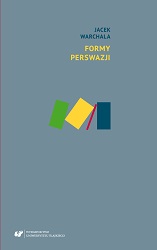Formy perswazji
Forms of persuasion
Author(s): Jacek Warchala
Subject(s): Language and Literature Studies, Theoretical Linguistics, Applied Linguistics
Published by: Wydawnictwo Uniwersytetu Śląskiego
Keywords: argumentation; manipulation; persuasion;information;
Summary/Abstract: Persuasion is a conscious communicative action the purpose of which is to influence the recipient and thereby to change her position on the subject in question or to throw her off her previous attitude or conviction. The broadest formula of persuasive activity, suggested by Jürgen Habermas’s idealist conception of communication, assumes the type of strategic communicative behaviour which implies influence exercising instead of consent. Within the consent-versus-influence model, or the model of formal pragmatics proposed by Habermas, the agreement of speech act participants is tantamount to the comprehension of a linguistically standarized utterance, and is nothing more than the knowledge of general conditions in which the listener may accept the utterance. Important here are interpersonal relations of participants in the communication process as well as intersubjective communicative community understood as the agreement on the accepted and shared norms of co-operation within the speech act, of shared propositonal knowledge and of trust in the interlocutor’s subjective sincerity. In the influence model which includes not only persuasion but also manipulation these three conditions may not be fulfilled. For example, the sender does not need to (and usually does not) articulate in a sincere way his suppositions, intentions, feelings or wishes; the listener may not share his/her knowledge, and the speaker may not need to articulate a true judgment. Finally, the listener may not accept interpersonal reference as legitimate, that is, she needs neither to know fully nor accept the superiority/ inferiority norm imposed by the speaker.
Series: Nauki społeczne
- E-ISBN-13: 978-83-226-3685-5
- Print-ISBN-13: 978-83-226-3684-8
- Page Count: 428
- Publication Year: 2019
- Language: Polish
- eBook-PDF
- Table of Content
- Introduction

